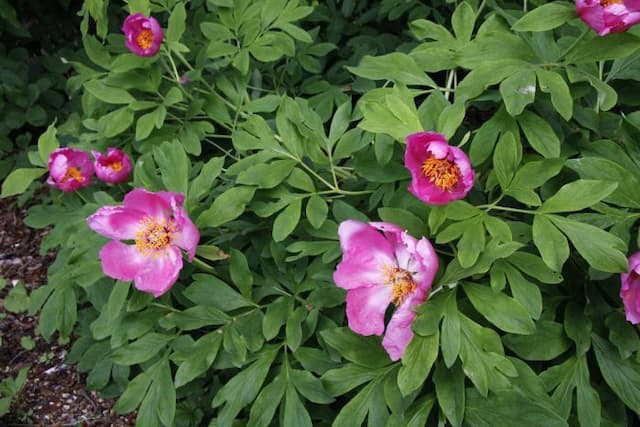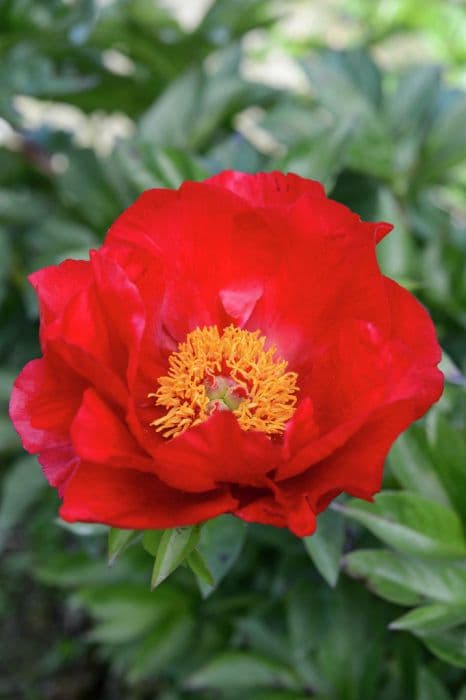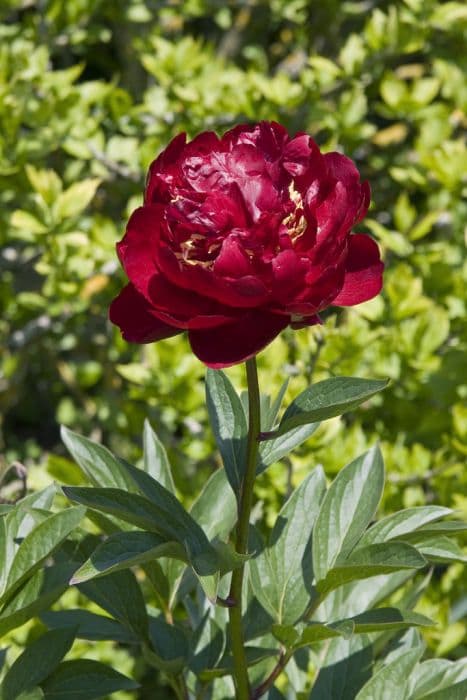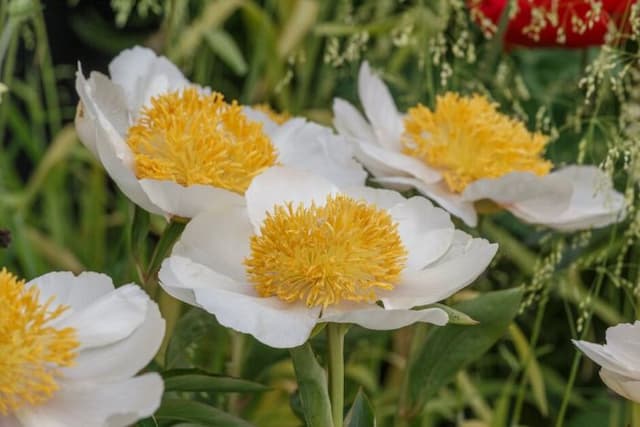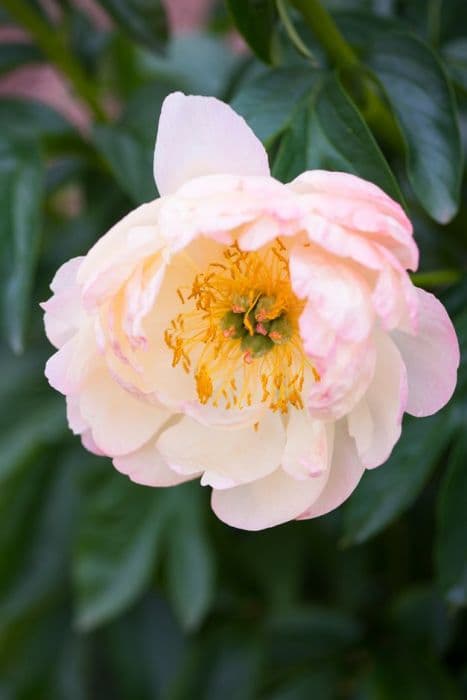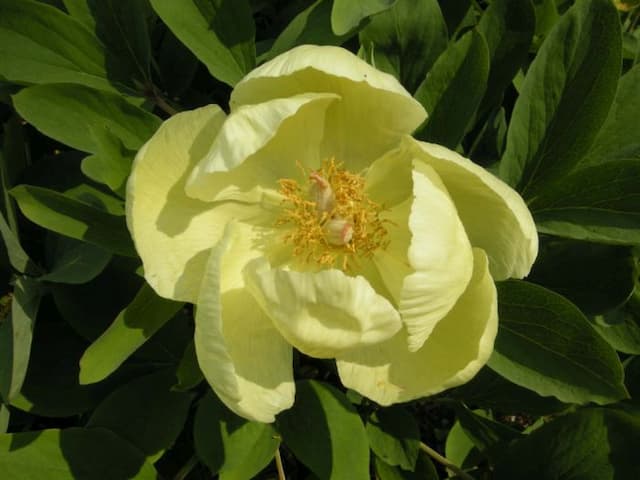Peony Paeonia lactiflora 'Albert Crousse'

ABOUT
The Paeonia lactiflora 'Albert Crousse' is a type of peony renowned for its exquisite blooms. This cultivar features large, fluffy double flowers that are a soft, blush pink, with the petals arranged in a dense, ruffled manner which gives them a sumptuous feel. The flowers emit a delightful fragrance that is a mix of sweet and subtle floral notes, making them a favorite in gardens for their scent as well as their beauty. The leaves of 'Albert Crousse' are a deep green color, providing a striking contrast to the softness of the blossoms. They are divided into leaflets that give the foliage a lacy appearance and grow on sturdy, upright stems which keep the flowers prominently displayed. This plant is deciduous, meaning it will lose its leaves in the fall but will regrow them in the spring, leading to the magnificent bloom season that is characteristic of peony plants.
About this plant
 Names
NamesFamily
Paeoniaceae
Synonyms
Chinese Peony, White Peony
Common names
Paeonia lactiflora 'Albert Crousse'.
 Toxicity
ToxicityTo humans
The common name for Paeonia lactiflora 'Albert Crousse' is peony. Peonies are generally not considered toxic to humans. Ingesting large quantities of any part of the plant is not advisable, but poisoning is rare. If someone were to consume a significant amount of peony, they might experience mild gastrointestinal irritation, including nausea, vomiting, or diarrhea. However, such cases are unusual, as the plant is not typically ingested due to its use as an ornamental plant rather than as food.
To pets
The common name for Paeonia lactiflora 'Albert Crousse' is peony. Peonies are considered to be only mildly toxic to pets, such as dogs and cats. If a pet were to ingest a significant amount of the plant, it could experience mild gastrointestinal upset, including symptoms like vomiting or diarrhea. Generally, the consumption of peonies by pets is not expected to cause severe poisoning but monitoring for symptoms and contacting a veterinarian if you suspect ingestion is always recommended. Preventing your pets from eating ornamental plants like peonies is a good precautionary measure.
 Characteristics
CharacteristicsLife cycle
Perennials
Foliage type
Deciduous
Color of leaves
Green
Flower color
Pink
Height
2-3 feet (60-90 cm)
Spread
2-3 feet (60-90 cm)
Plant type
Herb
Hardiness zones
3-8
Native area
Asia
Benefits
 General Benefits
General Benefits- Ornamental Appeal: Paeonia lactiflora 'Albert Crousse', commonly known as peony, is cherished for its large, fragrant double flowers that add striking visual appeal to gardens.
- Longevity: Peonies are long-lived perennials, often thriving for decades in the same location, making them a legacy plant for many gardens.
- Suitable for Cut Flowers: The blooms of peonies make excellent cut flowers, providing elegant and fragrant bouquets for indoor enjoyment.
- Seasonal Interest: Peonies offer seasonal interest in spring and early summer, filling the garden with color and texture when many other plants are not yet in full bloom.
- Low Maintenance: Once established, peonies require minimal care, being relatively drought tolerant and needing little attention beyond basic needs.
- Attract Pollinators: The flowers attract butterflies and bees, promoting pollination and supporting the health of the local ecosystem.
- Versatility in Landscaping: Peonies can be used in a variety of garden settings, including borders, flower beds, and as stand-alone specimens.
 Medical Properties
Medical Properties- Anti-inflammatory: Paeonia lactiflora has been traditionally used in herbal medicine to reduce inflammation.
- Analgesic: Compounds in this plant may have pain-relieving properties.
- Immunomodulatory effects: There is some evidence to suggest that Paeonia lactiflora may influence the immune system.
- Antioxidant: The roots contain compounds that may act as antioxidants.
 Air-purifying Qualities
Air-purifying QualitiesThis plant is not specifically known for air purifying qualities.
 Other Uses
Other Uses- As a natural fabric dye: The petals of Paeonia lactiflora 'Albert Crousse', commonly known as peony, can be used to create a soft pink or light red color in natural dyeing processes.
- Artistic inspiration: Artists may look to the peony's lush and full blooms as a subject for paintings, photography, and other visual arts, leading to culture and beauty inspired works.
- Culinary decoration: Petals of the peony can be used to adorn desserts or to create ornate presentations for special occasions like weddings.
- Fragrance extraction: The peony's scent can be extracted and used in perfumes and scented products, providing a floral essence to a variety of goods.
- Book pressing: Dried peony petals are perfect for book pressing and can be used in creating bookmarks, greeting cards, or in other paper crafts.
- Gift wrapping adornments: Fresh or dried peony flowers can be incorporated into gift wrapping designs to add a natural and elegant touch to presents.
- Biodegradable confetti: Dried peony petals can serve as eco-friendly confetti for celebrations, decomposing naturally and reducing waste.
- Special event décor: Peonies can serve as an element of décor for events, with their blooms enhancing the aesthetic of venues like hotels, restaurants, and churches.
- Ikebana: Peonies are a popular choice in the Japanese art of flower arranging, where they can symbolize good fortune, prosperity, and a happy marriage.
- Scenting linen: Dried peony petals can be tucked into drawers or linen closets to gently scent bedding, towels, and clothing.
Interesting Facts
 Feng Shui
Feng ShuiPeony is often used in Feng Shui to promote love and romance, and is sometimes referred to as the 'flower of riches and honor.' It is commonly placed in the southwest area of the garden or home to enhance relationship luck and is particularly beneficial for those seeking to attract or maintain a romantic partnership.
 Zodiac Sign Compitability
Zodiac Sign CompitabilityThe peony is not used in astrology practice.
 Plant Symbolism
Plant Symbolism- Richness and Honor: Peonies are often associated with wealth and high status, likely due in part to their full, lush blossoms and history of cultivation in imperial gardens.
- Romance and Love: With its full, round petals, the peony is frequently seen as a symbol of romantic love and is commonly used in wedding bouquets and decorations.
- Beauty in all Forms: Peonies embody the ideal of beauty in various cultures, signifying the idea that beauty encompasses more than just the outward appearance.
- Good Fortune and Happiness: Peonies are considered a good omen for a happy life and are often given as gifts to convey wishes for prosperity and joy.
- Compassion: Some interpretations suggest that the soft and gentle appearance of peonies can represent compassion towards others.
- Shame and Bashfulness: According to one Greek myth, peonies gained their name from the physician Paeon who was turned into a peony flower after trying to heal Hades, prompting some to associate the flower with feelings of embarrassment or shame.
 Water
WaterPeonies, including the 'Albert Crousse', should be watered deeply every week if there hasn't been substantial rainfall, especially during the growing season. It's important to avoid overhead watering to prevent fungal diseases; instead, water at the base of the plant. The soil should be kept evenly moist, but not waterlogged. During the summer, peonies may require about 0.5 to 1 inches of water weekly. The exact amount of water can vary depending on climate and soil conditions, but a general rule is to provide around 1 gallon of water per plant per week during dry periods.
 Light
LightPeonies thrive in full sun to partial shade. The 'Albert Crousse' peony prefers a spot that receives at least six hours of direct sunlight daily. However, in particularly hot climates, it will benefit from some afternoon shade to protect the blooms from excessive heat.
 Temperature
TemperaturePeonies, including 'Albert Crousse', prefer temperate climates and do best in a temperature range between 65°F to 75°F during the growing season. They can survive winter chill down to about -20°F, which actually helps them to break dormancy and bloom in the spring. Ideal growth occurs when the temperature does not exceed 85°F for extended periods.
 Pruning
PruningPeonies should be pruned to remove spent blooms after flowering, which for 'Albert Crousse' typically means deadheading in early summer. Cut back the foliage to the ground in fall after the leaves have died back, which prevents overwintering diseases. Annual pruning helps to promote healthy growth and ensures abundant blooms for the next season.
 Cleaning
CleaningAs needed
 Soil
SoilThe best soil mix for peonies like Paeonia lactiflora 'Albert Crousse' is well-drained, fertile, and loamy with a pH of 6.5 to 7.0. A mix of two parts garden soil, one part compost, and a handful of granular fertilizer is ideal to provide the necessary nutrients and structure. Peonies thrive in soil that provides adequate drainage to prevent root rot, while retaining enough moisture to sustain growth.
 Repotting
RepottingPeonies, including Paeonia lactiflora 'Albert Crousse', typically don't need frequent repotting and do well left undisturbed. If necessary, repotting should be done in the fall after the plant has become dormant. Peonies can be left in the same location for many years, as they are long-lived perennials and do not like to be moved.
 Humidity & Misting
Humidity & MistingPeonies like Paeonia lactiflora 'Albert Crousse' prefer average humidity conditions. The best humidity level for this plant is between 40-60%. They are relatively adaptable to different humidity levels, provided they have good air circulation to prevent fungal diseases.
 Suitable locations
Suitable locationsIndoor
Not ideal indoors; needs cold dormancy, full sun, well-ventilated area.
Outdoor
Plant in full sun, rich soil, and ensure good drainage.
Hardiness zone
3-8 USDA
 Life cycle
Life cycleThe life cycle of Paeonia lactiflora 'Albert Crousse', commonly known as the Chinese peony, begins with seed germination, which occurs in soil with adequate moisture and shading; however, cultivars like 'Albert Crousse' are more commonly propagated by division. After germination or division, the plant enters a vegetative growth phase, developing a sturdy stem and lush green foliage. Subsequent to establishing a firm root system, the peony begins the budding stage, where flower buds form and prepare to bloom in late spring or early summer. Once the temperature and light conditions are favorable, the plant reaches the flowering stage, bearing large, fragrant pink double blooms that are a highlight among garden ornamentals. After the flowering stage, the plant sets seeds if pollination occurs, though cultivated varieties are often propagated vegetatively rather than by seed. Finally, as the growing season ends, the peony enters dormancy during the fall and winter months, conserving energy below ground in its tuberous roots to repeat the cycle the following year.
 Propogation
PropogationPropogation time
Early Spring
The Paeonia lactiflora 'Albert Crousse', commonly known as the Chinese peony, is best propagated through division, which is the most popular method for this plant. The optimal time for dividing peonies is in the fall, when the plants have become dormant. This typically means dividing in September or October in the Northern Hemisphere. To propagate by division, carefully dig up the peony clump and gently shake off the excess soil, exposing the root system. Using a sharp knife, divide the clump into sections, making sure each division has at least three to five buds, known as "eyes," along with a good portion of root. It's important to replant the divisions immediately, setting the peony eyes approximately 1.5 to 2 inches (about 4 to 5 centimeters) below the soil surface. Ensure the divided plants are watered thoroughly and the soil around them is kept moist to help establish the newly divided peonies.
